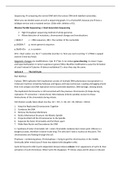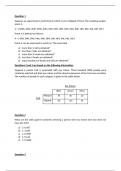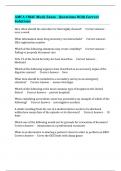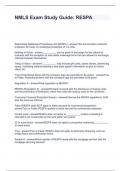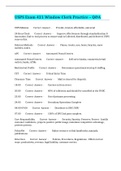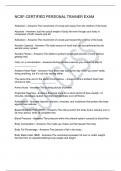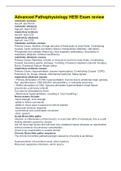THEORY PHYSICAL APPLICATIONS
Electrophysical agents
1 introduction
1.1 What are electrophysical agents?
EPA’s = a medical treatment that uses some kind of electrically generated energy in order to obtain a
physiological effect in the body.
→ this energy can cause a positive effect in the body. There are a lot of effects possible. The physical
reaction is the final goal because it is a way of treatment. There are 2 options to use the physical
reaction:
• Forcing the body to a change
• Tickling the body to use its own properties to change
EPA’s are those modalities that administer electrical, mechanical, thermal, electromagnetic or light
energy to the patient in order to provide physiological effects and therapeutic benefits. They are
primarily used in physiotherapy as an adjunct to another treatment and management techniques.
1.2 Terminology
Electrophysical agents =
• EPAs
• Electrophysical modalities
• Physical applications
• Electrotherapy (not exactly a synonym)
1.3 Various types of electrophysical agents
• Pain decreasing currents
• Muscle stimulating currents
• Laser
• Tecar
• Shockwaves
• …
1
,1.4 EPAs procedure
When you get a patient, you first do an anamnesis and a clinical examination → clinical reasoning →
is there an indication for PT? If there is, you have to see which treatment is the best for this patient
(= treatment plan). After a while, you will retest to see if the expected effects are present.
1.5 Why use EPAs?
The goal is to send the P home cured or in a much better shape. EPAs can make this easier, faster,
cheaper, more comfortable for the P and sometimes it is the only treatment possible.
2 Types of electrophysical agents
2.1 Pain decreasing currents
There are 7 ways for using pain decreasing currents symptomatically:
• Decreasing nerve conduction velocity: if this slows down, the pain will feel less intense
• Local hyperaemia (only in monophasic current, not in biphasic current)
• Decrease of substance-P
• Tissue repair
• Endorphins (for endorphin release, we usually use 400 µs)
• Gate control
• Decreasing and increasing pathways
2
, How much mA do you need to feel it (=group II fibres) and
how much to make it cause pain ( = group III and IV fibres).
The least amount of mA you give, you feel it and a little bit
more already causes pain. This is the purpose of endorphin
release mechanism.
2.1.1 Parameters
Pulse shape (asymmetrical, symmetrical…)
• Hardly makes a difference
• Pulse shape changes in the body due to filtering by skin and subcutaneous layers
→ only mono-/biphasic is important
• Modulation of the microcurrent type is important
• Make sure to recognise the current type by the pulse shape:
• Monophasic:
o Deliberate choice for polarising effect at the + or – electrode
o With MET: always – at pain site!
→ will have low galvanic component → local hyperaemia/skin burn risk
→ due to intensity at µA level negligible skin burn risk
• Biphasic:
o Low skin load → even at high mA level of TENS current
= due to absence of galvanic component
o Recommended in MET when no clear painful site can be defined. If there is a wound,
DON’T put the electrode in the wound.
o PRO: advantage for longer treatments (because of low skin load)
o CON: mA currents probably have only very little local effect
3
, Frequency:
• The higher, the more current → increase intensity with care!
• In the 1-15 Hz range: perceivable as different contractions, ranging from single to unfused
muscle shocks
• In the >25Hz range: perceivable as constant contraction ≈ simulating isometric contraction
• Frequency is linked to the desired effect = pain reduction based on a PDM
Pulse width:
• Very sensitive parameter: increase intensity with care when > 50µs
• In the 10-50µs range: current feels soft
• >200 µs range: harsher feeling (we can deliberately choose for this)
• Selection related to the PDMs and effect on afferent nerves
→ the shorter the pulse width, the more current only affects the large diameter afferents
→ the longer the pulse width, the more current will affect all afferents, large and small
Pulse interval:
• Burst TENS pulse interval option is perceived as a continuous on/off → helps to keep the
brain alert that sensory stimuli are being given
• Overall purpose: anti-adaptation = avoid to keep increasing the intensity
Modulation:
• The frequency spectrum must be wide enough to be perceivable → serves anti-adaptation
only when distinguishable
• Applies in most in 50-100Hz which serves the gate control parameter set extremely well
• Overall purpose: just like pulse interval, anti-adaptation = avoid to keep increasing the
intensity
• Exists in pulse width and intensity modulation as well
• A frequency spectrum always goes with frequency sweep times = time to go from one
frequency to the other (expressed as 0-2-0-2: 0 secs to go from 50 to 100 Hz, stay 2 secs at
100Hz, 0 secs to go back to 50Hz and 2 secs to stay at 50Hz (or other frequencies))
• No MET modulation: probably less effective because current equals less the cell’s natural
electrical activity → if available, always select modulated MET! One of the main goals of the
microcurrent is to mimic the cell’s natural activity.
Electrodes:
• Different types and sizes: carbon, self-adhesive, probe, plate, needle
• Size must be related to the purpose
• Position is milliamp vs. microamp related:
o Milliamp: local or vertebral (ramus cutaneus medialis) + make sure electrode
position is correct!!!!
o Microamp: only local with current flowing 3D trough the affected tissue(s)
• Thoughtfully use 1 channel/2 electrodes vs. 2 channels/4 electrodes options
→ think of the size, the pathology, the possibilities (e.g. in gait control 2 electrodes at injury
site and 2 at innervation site → 2 channel)
4
Electrophysical agents
1 introduction
1.1 What are electrophysical agents?
EPA’s = a medical treatment that uses some kind of electrically generated energy in order to obtain a
physiological effect in the body.
→ this energy can cause a positive effect in the body. There are a lot of effects possible. The physical
reaction is the final goal because it is a way of treatment. There are 2 options to use the physical
reaction:
• Forcing the body to a change
• Tickling the body to use its own properties to change
EPA’s are those modalities that administer electrical, mechanical, thermal, electromagnetic or light
energy to the patient in order to provide physiological effects and therapeutic benefits. They are
primarily used in physiotherapy as an adjunct to another treatment and management techniques.
1.2 Terminology
Electrophysical agents =
• EPAs
• Electrophysical modalities
• Physical applications
• Electrotherapy (not exactly a synonym)
1.3 Various types of electrophysical agents
• Pain decreasing currents
• Muscle stimulating currents
• Laser
• Tecar
• Shockwaves
• …
1
,1.4 EPAs procedure
When you get a patient, you first do an anamnesis and a clinical examination → clinical reasoning →
is there an indication for PT? If there is, you have to see which treatment is the best for this patient
(= treatment plan). After a while, you will retest to see if the expected effects are present.
1.5 Why use EPAs?
The goal is to send the P home cured or in a much better shape. EPAs can make this easier, faster,
cheaper, more comfortable for the P and sometimes it is the only treatment possible.
2 Types of electrophysical agents
2.1 Pain decreasing currents
There are 7 ways for using pain decreasing currents symptomatically:
• Decreasing nerve conduction velocity: if this slows down, the pain will feel less intense
• Local hyperaemia (only in monophasic current, not in biphasic current)
• Decrease of substance-P
• Tissue repair
• Endorphins (for endorphin release, we usually use 400 µs)
• Gate control
• Decreasing and increasing pathways
2
, How much mA do you need to feel it (=group II fibres) and
how much to make it cause pain ( = group III and IV fibres).
The least amount of mA you give, you feel it and a little bit
more already causes pain. This is the purpose of endorphin
release mechanism.
2.1.1 Parameters
Pulse shape (asymmetrical, symmetrical…)
• Hardly makes a difference
• Pulse shape changes in the body due to filtering by skin and subcutaneous layers
→ only mono-/biphasic is important
• Modulation of the microcurrent type is important
• Make sure to recognise the current type by the pulse shape:
• Monophasic:
o Deliberate choice for polarising effect at the + or – electrode
o With MET: always – at pain site!
→ will have low galvanic component → local hyperaemia/skin burn risk
→ due to intensity at µA level negligible skin burn risk
• Biphasic:
o Low skin load → even at high mA level of TENS current
= due to absence of galvanic component
o Recommended in MET when no clear painful site can be defined. If there is a wound,
DON’T put the electrode in the wound.
o PRO: advantage for longer treatments (because of low skin load)
o CON: mA currents probably have only very little local effect
3
, Frequency:
• The higher, the more current → increase intensity with care!
• In the 1-15 Hz range: perceivable as different contractions, ranging from single to unfused
muscle shocks
• In the >25Hz range: perceivable as constant contraction ≈ simulating isometric contraction
• Frequency is linked to the desired effect = pain reduction based on a PDM
Pulse width:
• Very sensitive parameter: increase intensity with care when > 50µs
• In the 10-50µs range: current feels soft
• >200 µs range: harsher feeling (we can deliberately choose for this)
• Selection related to the PDMs and effect on afferent nerves
→ the shorter the pulse width, the more current only affects the large diameter afferents
→ the longer the pulse width, the more current will affect all afferents, large and small
Pulse interval:
• Burst TENS pulse interval option is perceived as a continuous on/off → helps to keep the
brain alert that sensory stimuli are being given
• Overall purpose: anti-adaptation = avoid to keep increasing the intensity
Modulation:
• The frequency spectrum must be wide enough to be perceivable → serves anti-adaptation
only when distinguishable
• Applies in most in 50-100Hz which serves the gate control parameter set extremely well
• Overall purpose: just like pulse interval, anti-adaptation = avoid to keep increasing the
intensity
• Exists in pulse width and intensity modulation as well
• A frequency spectrum always goes with frequency sweep times = time to go from one
frequency to the other (expressed as 0-2-0-2: 0 secs to go from 50 to 100 Hz, stay 2 secs at
100Hz, 0 secs to go back to 50Hz and 2 secs to stay at 50Hz (or other frequencies))
• No MET modulation: probably less effective because current equals less the cell’s natural
electrical activity → if available, always select modulated MET! One of the main goals of the
microcurrent is to mimic the cell’s natural activity.
Electrodes:
• Different types and sizes: carbon, self-adhesive, probe, plate, needle
• Size must be related to the purpose
• Position is milliamp vs. microamp related:
o Milliamp: local or vertebral (ramus cutaneus medialis) + make sure electrode
position is correct!!!!
o Microamp: only local with current flowing 3D trough the affected tissue(s)
• Thoughtfully use 1 channel/2 electrodes vs. 2 channels/4 electrodes options
→ think of the size, the pathology, the possibilities (e.g. in gait control 2 electrodes at injury
site and 2 at innervation site → 2 channel)
4

